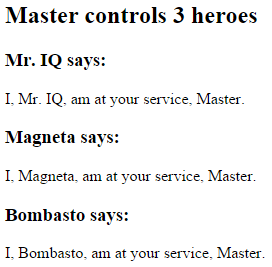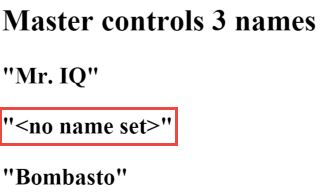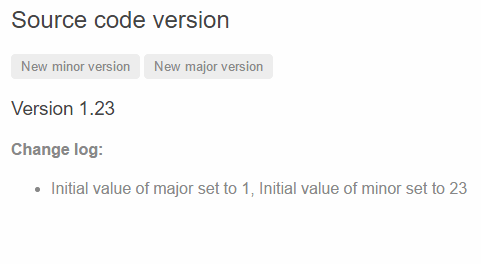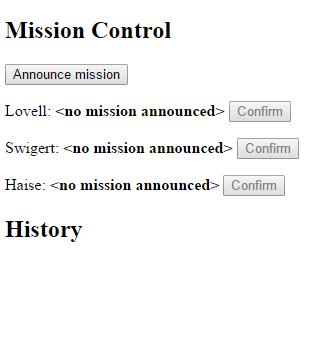本文同步發佈於:Claire's BLOG
這是接受數據的子元件的內容hero-child.component.ts
子元件輸要被輸入的屬性有兩個,以@Input開頭來做宣告:
import { Component, Input } from '@angular/core';
import { Hero } from './hero';
@Component({
selector: 'app-hero-child',
template: '
<h3>{{hero.name}} says:</h3>
<p>I, {{hero.name}}, am at your service, {{masterName}}.</p>
'
})
export class HeroChildComponent {
@Input() hero: Hero;
@Input('master') masterName: string;
}
而這是父元件的內容,透過屬性綁定將值塞進子元件中
父元件的完整程式碼如下:
import { Component } from '@angular/core';
import { HEROES } from './hero';
@Component({
selector: 'app-hero-parent',
template: '
<h2>{{master}} controls {{heroes.length}} heroes</h2>
<app-hero-child *ngFor="let hero of heroes"
[hero]="hero"
[master]="master">
</app-hero-child>
'
})
export class HeroParentComponent {
heroes = HEROES;
master = 'Master';
}
最後結果呈現:
可將子元件的input宣告改為getter和setter,如下面範例
import { Component, Input } from '@angular/core';
@Component({
selector: 'app-name-child',
template: '<h3>"{{name}}"</h3>'
})
export class NameChildComponent {
private _name = '';
@Input()
set name(name: string) {
this._name = (name && name.trim()) || '<no name set>';
}
get name(): string { return this._name; }
}
這樣當父元件傳空字串來時,子元件會自動輸出字樣
在子組件裡,除了上述使用getter及setter外,也可以利用ngOnChanges()來取得改變的變數並做出回應
ngOnChanges()會傳入所有被改變的值changes: {[propKey: string]: SimpleChange}
下面是一個使用範例
子元件內容
import { Component, Input, OnChanges, SimpleChange } from '@angular/core';
@Component({
selector: 'app-version-child',
template: '
<h3>Version {{major}}.{{minor}}</h3>
<h4>Change log:</h4>
<ul>
<li *ngFor="let change of changeLog">{{change}}</li>
</ul>
'
})
export class VersionChildComponent implements OnChanges {
@Input() major: number;
@Input() minor: number;
changeLog: string[] = [];
ngOnChanges(changes: {[propKey: string]: SimpleChange}) {
let log: string[] = [];
for (let propName in changes) {
let changedProp = changes[propName];
let to = JSON.stringify(changedProp.currentValue);
if (changedProp.isFirstChange()) {
log.push(`Initial value of ${propName} set to ${to}`);
} else {
let from = JSON.stringify(changedProp.previousValue);
log.push(`${propName} changed from ${from} to ${to}`);
}
}
this.changeLog.push(log.join(', '));
}
}
父元件內容
import { Component } from '@angular/core';
@Component({
selector: 'app-version-parent',
template: '
<h2>Source code version</h2>
<button (click)="newMinor()">New minor version</button>
<button (click)="newMajor()">New major version</button>
<app-version-child [major]="major" [minor]="minor"></app-version-child>
'
})
export class VersionParentComponent {
major = 1;
minor = 23;
newMinor() {
this.minor++;
}
newMajor() {
this.major++;
this.minor = 0;
}
}
最後成果如下圖
子元件的EventEmitter財產是一個輸出的屬性,通常用@Output來宣告,如下:
import { Component, EventEmitter, Input, Output } from '@angular/core';
@Component({
selector: 'app-voter',
template: '
<h4>{{name}}</h4>
<button (click)="vote(true)" [disabled]="voted">Agree</button>
<button (click)="vote(false)" [disabled]="voted">Disagree</button>
'
})
export class VoterComponent {
@Input() name: string;
@Output() onVoted = new EventEmitter<boolean>();
voted = false;
vote(agreed: boolean) {
this.onVoted.emit(agreed);
this.voted = true;
}
}
而父元件的內容如下:
import { Component } from '@angular/core';
@Component({
selector: 'app-vote-taker',
template: '
<h2>Should mankind colonize the Universe?</h2>
<h3>Agree: {{agreed}}, Disagree: {{disagreed}}</h3>
<app-voter *ngFor="let voter of voters"
[name]="voter"
(onVoted)="onVoted($event)">
</app-voter>
'
})
export class VoteTakerComponent {
agreed = 0;
disagreed = 0;
voters = ['Mr. IQ', 'Ms. Universe', 'Bombasto'];
onVoted(agreed: boolean) {
agreed ? this.agreed++ : this.disagreed++;
}
}
結果如圖:
下面是範例,將子元件使用#來宣告為template變數,就可以在父元件內自由使用子元件變數:
<h3>Countdown to Liftoff (via local variable)</h3>
<button (click)="timer.start()">Start</button>
<button (click)="timer.stop()">Stop</button>
<div class="seconds">{{timer.seconds}}</div>
<app-countdown-timer #timer></app-countdown-timer>
服務內容:
import { Injectable } from '@angular/core';
import { Subject } from 'rxjs/Subject';
@Injectable()
export class MissionService {
// Observable string sources
private missionAnnouncedSource = new Subject<string>();
private missionConfirmedSource = new Subject<string>();
// Observable string streams
missionAnnounced$ = this.missionAnnouncedSource.asObservable();
missionConfirmed$ = this.missionConfirmedSource.asObservable();
// Service message commands
announceMission(mission: string) {
this.missionAnnouncedSource.next(mission);
}
confirmMission(astronaut: string) {
this.missionConfirmedSource.next(astronaut);
}
}
父元件內容
import { Component } from '@angular/core';
import { MissionService } from './mission.service';
@Component({
selector: 'app-mission-control',
template: '
<h2>Mission Control</h2>
<button (click)="announce()">Announce mission</button>
<app-astronaut *ngFor="let astronaut of astronauts"
[astronaut]="astronaut">
</app-astronaut>
<h3>History</h3>
<ul>
<li *ngFor="let event of history">{{event}}</li>
</ul>
',
providers: [MissionService]
})
export class MissionControlComponent {
astronauts = ['Lovell', 'Swigert', 'Haise'];
history: string[] = [];
missions = ['Fly to the moon!',
'Fly to mars!',
'Fly to Vegas!'];
nextMission = 0;
constructor(private missionService: MissionService) {
missionService.missionConfirmed$.subscribe(
astronaut => {
this.history.push(`${astronaut} confirmed the mission`);
});
}
announce() {
let mission = this.missions[this.nextMission++];
this.missionService.announceMission(mission);
this.history.push(`Mission "${mission}" announced`);
if (this.nextMission >= this.missions.length) { this.nextMission = 0; }
}
}
子元件內容
import { Component, Input, OnDestroy } from '@angular/core';
import { MissionService } from './mission.service';
import { Subscription } from 'rxjs/Subscription';
@Component({
selector: 'app-astronaut',
template: '
<p>
{{astronaut}}: <strong>{{mission}}</strong>
<button
(click)="confirm()"
[disabled]="!announced || confirmed">
Confirm
</button>
</p>
'
})
export class AstronautComponent implements OnDestroy {
@Input() astronaut: string;
mission = '<no mission announced>';
confirmed = false;
announced = false;
subscription: Subscription;
constructor(private missionService: MissionService) {
this.subscription = missionService.missionAnnounced$.subscribe(
mission => {
this.mission = mission;
this.announced = true;
this.confirmed = false;
});
}
confirm() {
this.confirmed = true;
this.missionService.confirmMission(this.astronaut);
}
ngOnDestroy() {
// prevent memory leak when component destroyed
this.subscription.unsubscribe();
}
}
結果如下圖:
更多本篇完整範例請見: live example / download example
